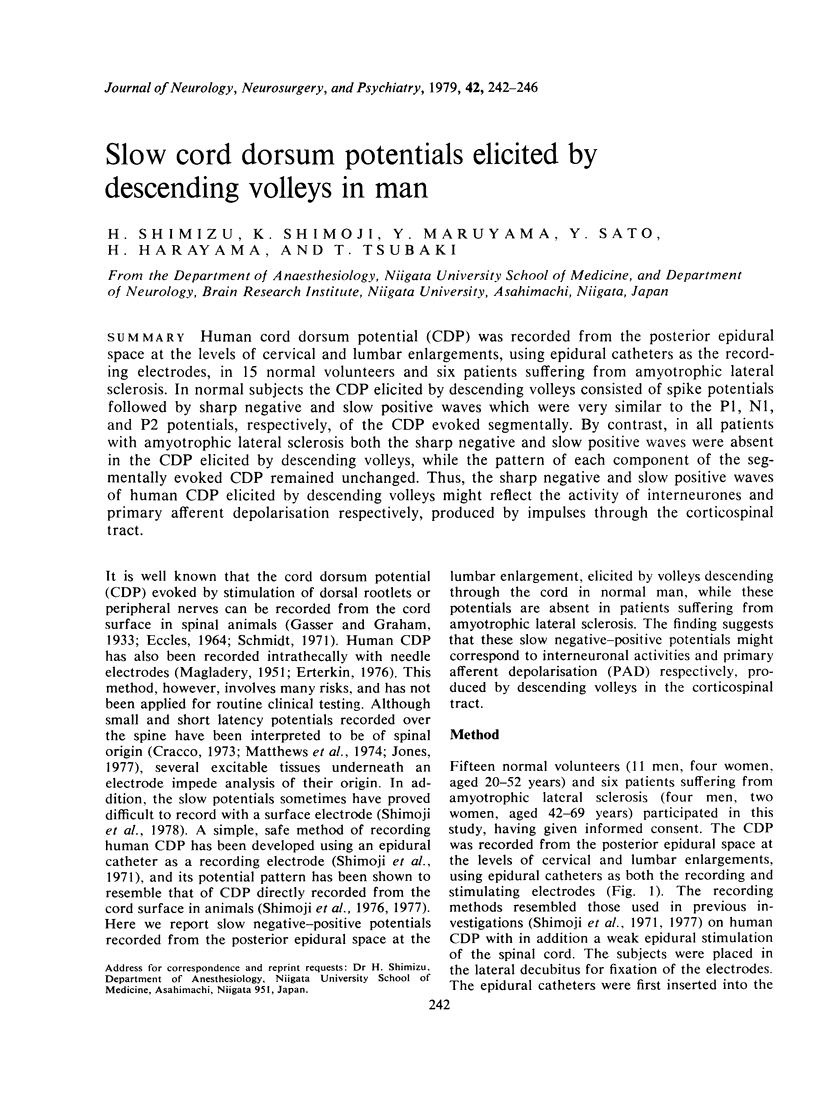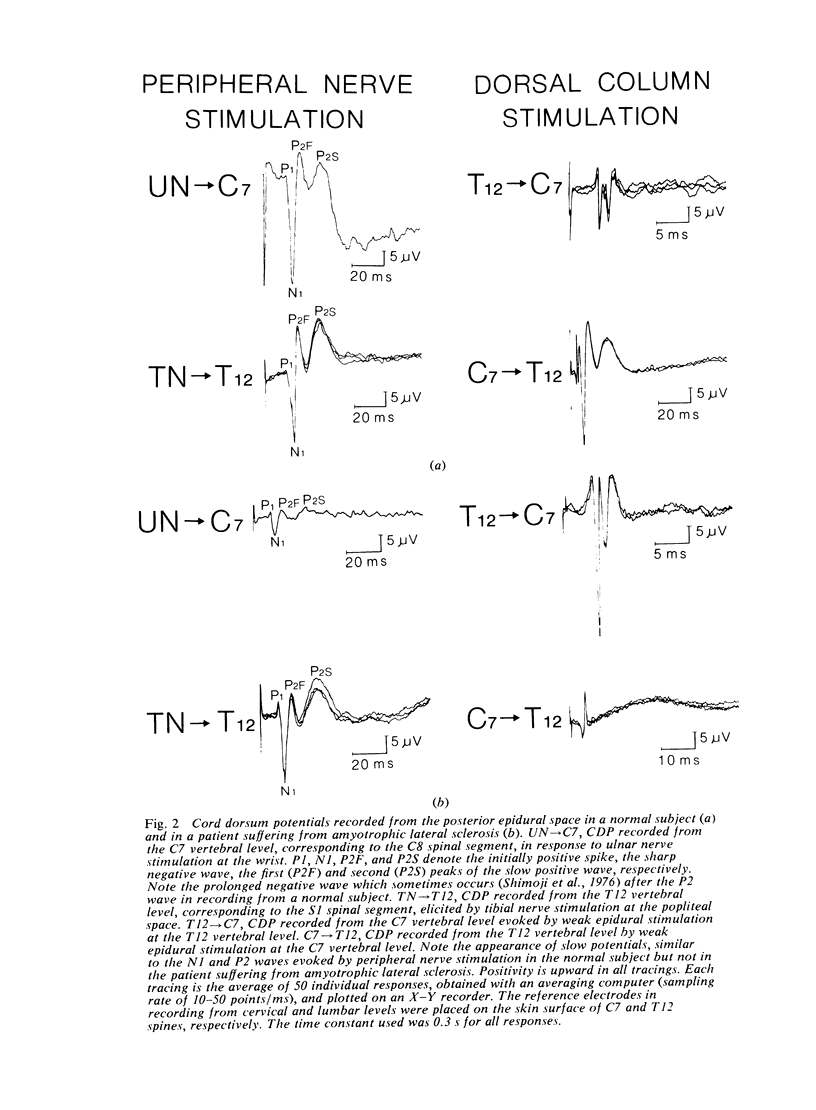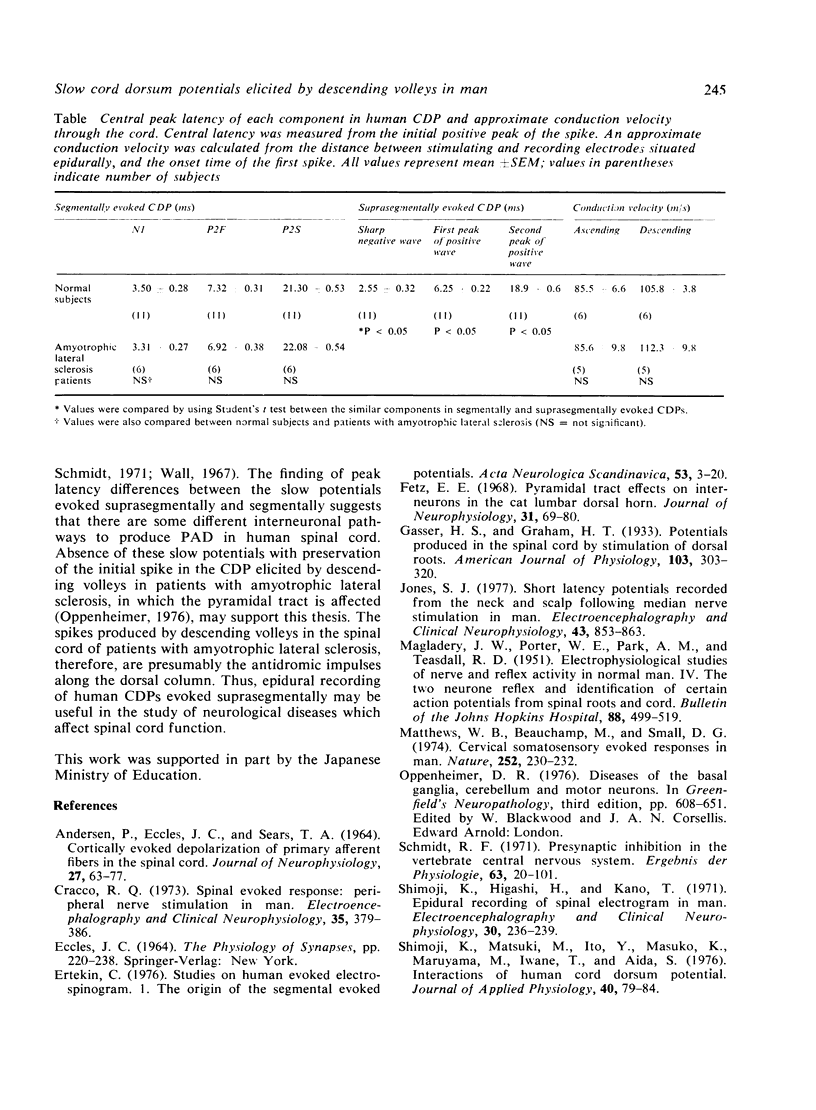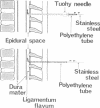Abstract
Human cord dorsum potential (CDP) was recorded from the posterior epidural space at the levels of cervical and lumbar enlargements, using epidural catheters as the recording electrodes, in 15 normal volunteers and six patients suffering from amyotrophic lateral sclerosis. In normal subjects the CDP elicited by descending volleys consisted of spike potentials followed by sharp negative and slow positive waves which were very similar to the P1, N1, and P2 potentials, respectively, of the CDP evoked segmentally. By contrast, in all patients with amyotrophic lateral sclerosis both the sharp negative and slow positive waves were absent in the CDP elicited by descending volleys, while the pattern of each component of the segmentally evoked CDP remained unchanged. Thus, the sharp negative and slow positive waves of human CDP elicited by descending volleys might reflect the activity of interneurones and primary afferent depolarisation respectively, produced by impulses through the corticospinal tract.
Full text
PDF




Images in this article
Selected References
These references are in PubMed. This may not be the complete list of references from this article.
- ANDERSEN P., ECCLES J. C., SEARS T. A. CORTICALLY EVOKED DEPOLARIZATION OF PRIMARY AFFERENT FIBERS IN THE SPINAL CORD. J Neurophysiol. 1964 Jan;27:63–77. doi: 10.1152/jn.1964.27.1.63. [DOI] [PubMed] [Google Scholar]
- Cracco R. Q. Spinal evoked response: peripheral nerve stimulation in man. Electroencephalogr Clin Neurophysiol. 1973 Oct;35(4):379–386. doi: 10.1016/0013-4694(73)90195-8. [DOI] [PubMed] [Google Scholar]
- Ertekin C. Studies on the human evoked electrospinogram. I. The origin of the segmental evoked potentials. Acta Neurol Scand. 1976 Jan;53(1):3–20. doi: 10.1111/j.1600-0404.1976.tb04321.x. [DOI] [PubMed] [Google Scholar]
- Fetz E. E. Pyramidal tract effects on interneurons in the cat lumbar dorsal horn. J Neurophysiol. 1968 Jan;31(1):69–80. doi: 10.1152/jn.1968.31.1.69. [DOI] [PubMed] [Google Scholar]
- Jones S. J. Short latency potentials recorded from the neck and scalp following median nerve stimulation in man. Electroencephalogr Clin Neurophysiol. 1977 Dec;43(6):853–863. doi: 10.1016/0013-4694(77)90008-6. [DOI] [PubMed] [Google Scholar]
- MAGLADERY J. W., PORTER W. E., PARK A. M., TEASDALL R. D. Electrophysiological studies of nerve and reflex activity in normal man. IV. The two-neurone reflex and identification of certain action potentials from spinal roots and cord. Bull Johns Hopkins Hosp. 1951 Jun;88(6):499–519. [PubMed] [Google Scholar]
- Matthews W. B., Beauchamp M., Small D. G. Cervical somato-sensory evoked responses in man. Nature. 1974 Nov 15;252(5480):230–232. doi: 10.1038/252230a0. [DOI] [PubMed] [Google Scholar]
- Schmidt R. F. Presynaptic inhibition in the vertebrate central nervous system. Ergeb Physiol. 1971;63:20–101. doi: 10.1007/BFb0047741. [DOI] [PubMed] [Google Scholar]
- Shimoji K., Higashi H., Kano T. Epidural recording of spinal electrogram in man. Electroencephalogr Clin Neurophysiol. 1971 Mar;30(3):236–239. doi: 10.1016/0013-4694(71)90059-9. [DOI] [PubMed] [Google Scholar]
- Shimoji K., Matsuki M., Ito Y., Masuko K., Maruyama M., Iwane T., Aida S. Interactions of human cord dorsum potential. J Appl Physiol. 1976 Jan;40(1):79–84. doi: 10.1152/jappl.1976.40.1.79. [DOI] [PubMed] [Google Scholar]
- Shimoji K., Matsuki M., Shimizu H. Wave-form characteristics and spatial distribution of evoked spinal electrogram in man. J Neurosurg. 1977 Mar;46(3):304–313. doi: 10.3171/jns.1977.46.3.0304. [DOI] [PubMed] [Google Scholar]
- Shimoji K., Shimizu H., Maruyama Y. Origin of somatosensory evoked responses recorded from the cervical skin surface. J Neurosurg. 1978 Jun;48(6):980–984. doi: 10.3171/jns.1978.48.6.0980. [DOI] [PubMed] [Google Scholar]
- Wall P. D. The laminar organization of dorsal horn and effects of descending impulses. J Physiol. 1967 Feb;188(3):403–423. doi: 10.1113/jphysiol.1967.sp008146. [DOI] [PMC free article] [PubMed] [Google Scholar]



